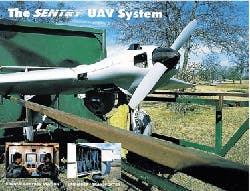Army to select tactical UAV supplier for potential 44 systems
By John Rhea
FORT HUACHUCA, Ariz. — The U.S. Army has wrapped up the flyoff phase of the competition for its Tactical Unmanned Aerial Vehicle (TUAV) , and is imminently expected to choose the winning contractor from among four competing teams.
At stake now is a low-rate initial production contract to supply nine systems over the next two years, but the Army is looking for 44 production systems, including four for training, by 2010.
Since the TUAV is essentially a platform for mounting a variety of sensors, this represents an opportunity for advanced electronics technology in sensors and data handling.
Constraining these functions is the Army`s requirement that the vehicles weigh only 200 pounds, be able to remain on station for at least four hours, and cost no more than $4 million per system, which consists of the ground station and three flight vehicles.
The competing vehicles and their contractors are:
- Gnat, General Atomics Aeronautical Systems Inc. in San Diego;
- Outrider, Alliant Techsystems of Hopkins, Minn.;
- Sentry, TRW Tactical Systems in San Diego; and
- Shadow, AAI Corp. in Hunt Valley, Md.
The competitors have begun talking with potential electronics suppliers, and are teaming with other UAV firms. On the AAI and TRW teams is Israel Aircraft Industries in Tel Aviv, Israel, for example. The AAI and TRW teams also are discussing potential business arrangements with Raytheon Systems Co. of Lexington, Mass.
Among the firms basing their efforts on previous, larger UAVs are General Atomics with the Predator and TRW with the Hunter.
At a minimum, the winning design must deliver forward-looking infrared and video (color or black and white) images as standard features. Yet the Army may later order a number of options such as synthetic aperture radar and electronic intelligence gathering.
The idea is to have one family of UAVs available to the battlefield commander, who can choose the intelligence he needs based on the current situation. The subsystems will be provided either as government-furnished equipment or under subcontracts from the winning prime contractor.
Other Army requirements include the ability to take off and land within an area 200 meters by 50 meters, a range of at least 50 kilometers, use of standard fuel (preferably diesel or jet fuel), ability of each system of three UAVs to provide 12 continuous hours on station per day, and deployment of each complete system to the battle area in two C-130 transport aircraft.
Communications will be line of sight and must be compatible with the Army`s battlefield digitization program.
Army leaders are ready to select a new generation of unmanned aerial vehicles to serve as platforms for a wide variety of sensors.

